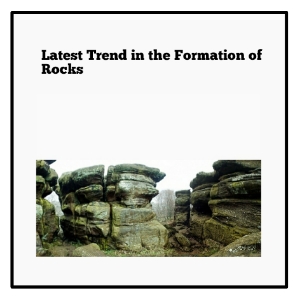What is a Rock?
A rock can be defined as any mineral materials of the earth. The earths crust consists of rocks according to researches. A rock my be the combination of different mineral elements such as silica which contains silicon and oxygen depending on the type of rock.
Types of Rocks
All rocks are classified into three major types which includes: igneous rock, sedimentary rocks, metamorphic rocks, based on their origin, mode of formation amd appearance.All rocks differs from one another in texture, structure, colours, permeability, mode of occurrence and degree of resistance to denudation.
Igneous Rock
Igneous rocks are glassy in appearance. This rock doesn't occurs in layers that is, they are non-stratified rocks. They are very light and dark in colour.They do not contains fossils.Igneous rocks are crystalline in structure that is, they contains crystal. They are always hard. This rock is resistant to erosion and other climatic factors.
Mode of Formation of Igneous Rocks
Igneous rocks are formed by the cooling and solidification of molten rocks called magma that is ejected from beneath the earths crust. The magma, which result from the high temperature and pressure beneath the earth, force itself towards the earth's surface through cracks.As the magma moves towards the surface, it comes in contact with lower temperature , hence, it cools and solidifies to form igneous rocks.
Types of Igneous Rocks
There are two types of igneous rocks which are:
(a) Plutonic (or instrusive) igneous rocks
These are rocks formed when the molten magma cools and solidifies slowly before it gets to the surface of the earth to form large crystals. As a result of prolonged erosion, the plutonic igneous rocks will later be exposed to the surface.
Examples of plutonic igneous rocks are granite, gabbro and diorite.
(b) Volcanic (or extrusive) igneous rocks:
These rocks are formed when the molten magma cools and solidifies rapidly on getting to the surface of the earth to form small crystals. An example of volcanic igneous rock is basalt.
Sedimentary Rocks
Characteristics of Sedimentary Rocks
(i) They occur in layers or strata or sheets.
(ii) The rocks are coarse in texture.
(iii) They do not exist in crystals, i.e, they are non-crystalline in structure.
(iv) They contain fossils of plants and animals.
(v) They are not resistant to erosion.
(vi) They are soft.
(vii) They react with weak acid e.g. dilute HCL.
Mode of Formation
Sedimentary rocks are formed from sediments deposited either by water, by wind or by ice.These sediment accumulates together in layers or strata, and on the top the other after very long period of time, the layers becomes hardened by the compression to form sedimentary rocks.
The bedding plane is referred to as the sedimentary rocks that stratified rocks and plane between two strata.
Types of Sedimentary Rocks
There are mainly three types of sedimentary rocks which includes:
(a) Mechanically-formed Sedimentary Rocks
These are formed from sediments of other rocks that have accumulated and cementedt together over a long period of time. Examples include: sandstone, breccia, shale, clay and conglomerate.
(b) Organically-formed Sedimentary Rocks
These are rocks formed from the remains of living organisms. When sedimentary rocks are formed from the remains of animals like corals or fish shells, such rocks are called calcareous rocks, e.g, limestone and chalk. But when sedimentary rocks are formed from the remains of vegetable matter such as swamps and forest, they are called carbonaceous rocks. Examples include, coal, peat, lignite, petroleum, etc.
(c) Chemically- formed sedimentary rocks
There are the rocks that are produced chemically from the solution of rocks.Examples include potash, sodium, chloride, dolomite, gypsum and nitrate.
Metamorphic Rocks
Characteristics of Metamorphic Rocks
1. Some parts of this may occurs in layers or strata
2. The rocks many be hard or soft
3. They may contain some fossils.
4. They are non-crystalline in structure.
5. They usually exists in different colours and texture.
Mode of Formation of Metamorphic Rocks
Metamorphic are rocks that are changed. These rocks are the one from pre-existing igneous or sedimentary rocks which have been changed as a result of great heat and pressure. The real character and look may be greatly altered or changed by such forces. Examples of metamorphic rocks includes slate,marble, quartzite,gneiss, schist, and graphite.For example, slate is formed from clay soil, quartzite from sandstone, gneiss is formed from granites, marble is made from limestone and schist is made from shale.
Economic improtance of rocks in Agriculture
1. Formation of soil - Some soil will be formed from the disintegration of rocks .
2. Sources of plant nutrients - Some plant nutrients like iron, calcium, potassium etc are derieved from rocks.
3. Construction purposes : Some rocks are used in building farm building and used in the construction of roads. Examples of the ones used in construction includes granites and sand stones.
4. Erosion control : Rocks are used to control erosion by piling it up across the sloppy lands.
5. Obstacles of farm implement: Rocks are generally a source of hinderace to free farm operation of farm implement.
Economic improtance of rocks to man
1. Domestic uses : Some rocks like granites are used for domestic purposes.An example of domestic use of rocks is using it to make grinding stone.
2 Source of metals : Rocks are the source of metals which are removed from mines. E.g gold, silver, copper, aluminum etc.
3. As ornamentals : some beautiful rocks like marble are being polished as ornamentals for decorating floors, walls of building , churches etc.
4. Sources of Food: Rock salt such as sodium chloride ( table salt) from sedimentary rocks, provides minerals used in cooking of food and supplying nutrients.
5. Sources of Minerals : Some rocks are sources of minerals such as gold, diamond , limestone, petroleum etc which can generate some income to the Government.
6. Raw materials for industries: Some sedimentary rocks are used as raw materials for Industries.For example limestone is used for making cement. Dolomite and marble are used to manufacture glass and house paints.







0 Comments